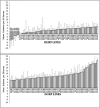Toxicological Study and Genetic Basis of BTEX Susceptibility in Drosophila melanogaster
- PMID: 33193742
- PMCID: PMC7593870
- DOI: 10.3389/fgene.2020.594179
Toxicological Study and Genetic Basis of BTEX Susceptibility in Drosophila melanogaster
Abstract
Benzene, toluene, ethylbenzene and xylene, also known as BTEX, are released into environmental media by petroleum product exploratory and exploitative activities and are harmful to humans and animals. Testing the effects of these chemicals on a significantly large scale requires an inexpensive, rapidly developing model organism such as Drosophila melanogaster. In this study, the toxicological profile of benzene, toluene, ethylbenzene, p-xylene, m-xylene, and o-xylene in D. melanogaster was evaluated. Adult animals were monitored for acute toxicity effects. Similarly, first instar larvae reared separately on the same compounds were monitored for the ability to develop into adult flies (eclosion). Further, the impact of fixed concentrations of benzene and xylene on apoptosis and mitosis were investigated in adult progenitor tissues found in third instar larvae. Toluene is the most toxic to adult flies with an LC50 of 0.166 mM, while a significant and dose-dependent decrease in fly eclosion was observed with benzene, p-xylene, and o-xylene. An increase in apoptosis and mitosis was also observed in animals exposed to benzene and p-xylene. Through Genome Wide Association Screening (GWAS), 38 regions of the D. melanogaster genome were identified as critical for responses to p-xylene. This study reveals the strength of D. Melanogaster genetics as an accessible approach to study BTEX compounds.
Keywords: BTEX; DGRP; Drosophila melanogaster; GWAS; apoptosis; development; imaginal disk.
Copyright © 2020 Adebambo, Fox and Otitoloju.
Figures





References
LinkOut - more resources
Full Text Sources
Molecular Biology Databases

